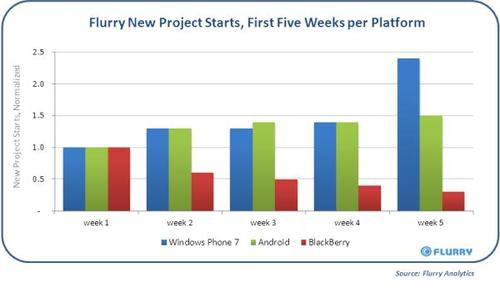In the history of high tech corporate incumbents facing market disruption, Nokia CEO Stephen Elop’s blunt, provocative “burning platform” memo, where he describes a blazing platform, upon which his company has poured gasoline and now must abandon for its very survival, has become an instant classic. While history will ultimately reveal whether Mr. Elop’s bold call to action was delivered in time to save Nokia, Flurry can look to trends from the app development community as an early indicator for whether it will support the new Nokia-Microsoft (“Nokiasoft”) partnership.
Flurry periodically measures the relative support that developers dedicate to different platforms by tracking new application starts within its system, especially when there is a major market event. For example, prior to the shipment of Apple’s iPad, Flurry reported both increased activity and rates of project starts. A Flurry new project start is recorded when a developer adds the Flurry SDK to its pre-release application. 38,000 companies have created projects using Flurry.
This week, with the early speculation and subsequent announcement that Nokia and Microsoft would partner, Flurry measured a 66% increase in Windows Phone 7 project starts over last week. However, since we only began Flurry Analytics support for Microsoft Windows Phone 7 five weeks ago, we went back in our records to ensure what we were seeing was not an aberration.
For an apples-to-apples comparison, we studied Flurry new project starts for the first five weeks of support for each of the following platforms: Android, BlackBerry and Windows Phone 7. We then normalized the measurement to show a relative vs. absolute comparison (percentages vs. actual numbers). The results are presented below.

Reviewing the chart, it is interesting to note the similarity in relative growth of Android and Windows Phone 7 project starts. When Flurry launched its support for Android in October 2008, there was doubt in the industry around the viability of Android as a development platform. Back then, the sentiment was that Android would capture market share as a mobile operating system, but not necessarily as an application development platform or an ecosystem where developers could thrive. 180,000 apps later, Android answered its critics.
Likewise, prior to today’s announcement, many questioned the viability of Windows Phone 7 as an operating system that developers would support. Moreover, there was doubt that Microsoft as a company could muster enough momentum to gain relevance at this stage the mobile platform race. From Flurry’s point of view, this week’s spike in Windows Phone 7 developer activity shows that developers not only believe Nokia has given Microsoft Windows Phone7 a shot in the arm, but also that Nokia and Microsoft together can build a viable ecosystem.
While Android ultimately became a vibrant platform, it’s also important to note the relative drop off in BlackBerry’s project starts over the same initial period. It appears that developers voted down BlackBerry as a viable third contender to Apple and Google in the first five weeks of Flurry’s support. Months later, the market proved these developers right.
Yet, despite the rising development cost to build for multiple platforms, developers continue to demonstrate their willingness to support a multi-platform world, where they believe real business opportunity exists. As one of our developer-customers once told us “I would develop in assembly language, if I thought I could make money.” With spiking support for Nokia and Microsoft, developers are showing us they believe.